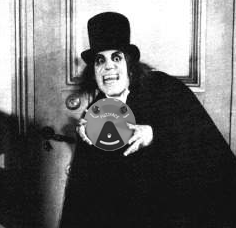
Lon Chaney was an early Fuzz Face user.
It is a truth universally acknowledged that a guitarist in possession of a single Face Fuzz must be in want of cool Fuzz Face mods. (Sorry, Jane.)
Case in point: The comments section for the new Fuzz Face project.
We’re far from the first to cover this ground. In fact, I should have mentioned a couple of great articles on Fuzz Face mods. We’ve talked about the technique of using sockets in your build so you can audition multiple components. Years ago DIYer Gary Burchett took this notion to its logical conclusion with the Multi-Face, a Fuzz Face with most of the components socketed. It’s definitely worth trying this. Meanwhile, this Instructables project by randofo explains how to create a super-versatile Fuzz Face using switchable components.
Trust me — despite the simplicity of the circuit and the sheer number of adventurous souls who have deconstructed and reconstructed it, it’s hard not to play around with it and find something cool and new. That too is a truth universally acknowledged!








Beavis Audio put this up a while back suggesting several switchable mods for the BYOC Fuzz Face kit: https://www.beavisaudio.com/Projects/FuzzLab/byocfuzzmods.htm
For basic tweaking and tuning, though, R.G.’s Geofex article (mentioned previously) is my first stop: https://geofex.com/Article_Folders/fuzzface/fffram.htm
Given my aversion to soldering, I can’t imagine building something with a thousand settings only to discover that 3 of them rocked.
My fuzz factory clone makes all kinds of noises, with it’s endlessly tweakable circuit, but inevitably I come back to setting it where it behaves like a fuzz face. (As I understand it, the fuzz factory is like a fuzz face wired backwards with a bunch of components wired to pots instead of being fixed values, to over-simplify.) It’s so responsive to volume and tone knob tweaks there, that I really don’t want it to do anything else…
What I usually do after reading articles like this is to search out some technical articles that explain exactly why, e.g. germanium transistors sound the way they do in fuzz pedals. Believe it or not, it seems that about 10% of electrical engineering major senior projects are DSP effects systems for guitar. Hey if DSP had been affordable when I graduated I would have tried also. So I’ve found PLENTY of those articles.
However, the only info I can track down about the “sound” of germanium transistors is all to be found in places like right here, or various DIY stomp box fora, etc. etc. I found some interesting stories about the guys at Texas Instruments who made the first point contact transistors, but they weren’t really using them for fuzz pedals at that time.
I’ve read that it could be:
a) Low frequency response (would contribute to the smoothness)
b) Leakage current (not sure what that would do to the sound)
c) Lower forward voltage compared to silicon (starts conducting sooner)
But, honestly, I’m still mystified. And that’s OK.
The Fuzz Face is pretty cool. It’s got that sound everyone loves. I can’t decide if it just sounds good, or if I’ve been trained to like “that” sound?
As far as DIY projects go, I really dig that Instructables article. I like the way he’s got 4 different transistors on a switch.
I know what you mena about the Fuzz Factory, There’s a lot of sounds there, I really only use a narrow range. Sometimes there’s just too much adjustment to find something useful with it.
Yeah, I could probably make three out of five knobs on my Fuzz Factory into fixed value components and be quite happy. I prefer Joe’s approach: taste-testing components till you get ’em where you want ’em and leaving the controls dead simple. Still, the Fuzz Factory really shines in recording scenarios when you need unusual textures. I reviewed and demo’d mine here: https://inspireformation.blogspot.ca/2013/05/my-uh-funky-fuzz-factory-clone.html
Wow, great link/post Dave! You really make me look like a deadbeat with some of my half-assed reports! Sounds fab too.
I know what you mean about the complexity/simplicity balance. One “original” design I’ve come up with is another Fuzz Face derivative designed to provide some of those freaky/”broken” sounds in a more direct way. I haven’t shared the schematic yet, ’cause I’m still hoping to go commercial with it at some point. Fuzz Box Girl made a nice demo of it, though: https://www.fuzzboxgirl.com/2011/10/19/filth-fuzz-by-gore-pedals-demo-my-bloody-valentine-type-tones/.
I’m dead serious when I say you can still get new sounds from this picked-over circuit!
Lovin’ that Freak Fuzz! Great control scheme and great textures on tap! I’m guessing germanium, but it can get some cool silicon-esque mud as well.